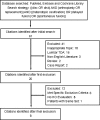Prevalence of heterotopic ossification after cervical total disc arthroplasty: a meta-analysis
- PMID: 22134486
- PMCID: PMC3326119
- DOI: 10.1007/s00586-011-2094-x
Prevalence of heterotopic ossification after cervical total disc arthroplasty: a meta-analysis
Abstract
Background: Heterotopic ossification (HO) is a well-known complication after total hip and knee arthroplasty. But limited studies have focused on prevalence of HO following cervical total disc arthroplasty (CTDA) and the published data show controversial results.
Objective: The purpose of this review is to investigate the prevalence of HO following CTDA by meta-analysis.
Methods: The literatures were collected from PubMed, Embase and Cochrane library by using keywords as ([disc or disk] and [arthroplasty or replacement]) and (HO or delayed fusion or spontaneous fusion). The original studies were eligible only if the prevalence of HO and of advanced HO (Grade 3-4 according to McAfee) were investigated. A meta-analysis was then performed on collected data. Statistical heterogeneity across the various trials was tested using Cochran's Q, statistic and in the case of heterogeneity a random effect model was used. Tests of publication bias and sensitivity analysis were also performed.
Results: Our data showed that the pooled prevalence of HO was 44.6% (95% confidence interval (CI), 37.2-45.6%) 12 months after CTDA and 58.2% (95% CI, 29.7-86.8%) 24 months after CTDA, while the advanced HO was 11.1% (95% CI, 5.5-16.7%) and 16.7% (95% CI, 4.6-28.9%), respectively. A significant heterogeneity was obtained. There was no publication bias and individual study had no significant effect on the pooled prevalence estimate.
Conclusion: Higher prevalence of HO was observed following CTDA, although HO was reported to be unrelated to the clinical improvement. It suggests that cervical disc replacement should be performed cautiously before obtaining long-term supporting evidence.
Level of evidence: Prognostic level III.
Figures



Similar articles
-
The prevalence of heterotopic ossification among patients after cervical artificial disc replacement: A systematic review and meta-analysis.Medicine (Baltimore). 2017 Jun;96(24):e7163. doi: 10.1097/MD.0000000000007163. Medicine (Baltimore). 2017. PMID: 28614250 Free PMC article.
-
An analysis of heterotopic ossification in cervical disc arthroplasty: a novel morphologic classification of an ossified mass.Spine J. 2013 Apr;13(4):408-20. doi: 10.1016/j.spinee.2012.11.048. Epub 2013 Jan 16. Spine J. 2013. PMID: 23332520
-
Incidence and risk factors of heterotopic ossification after cervical Baguera C disc arthroplasty.J Neurosurg Spine. 2024 Mar 22;40(6):773-781. doi: 10.3171/2024.1.SPINE23744. Print 2024 Jun 1. J Neurosurg Spine. 2024. PMID: 38518295
-
Early development and progression of heterotopic ossification in cervical total disc replacement.J Neurosurg Spine. 2012 Jan;16(1):31-6. doi: 10.3171/2011.8.SPINE11303. Epub 2011 Oct 14. J Neurosurg Spine. 2012. PMID: 21999390
-
Complications of cervical total disc replacement and their associations with heterotopic ossification: a systematic review and meta-analysis.Eur Spine J. 2020 Nov;29(11):2688-2700. doi: 10.1007/s00586-020-06400-z. Epub 2020 Apr 11. Eur Spine J. 2020. PMID: 32279116
Cited by
-
2021 Position Statement From the International Society for the Advancement of Spine Surgery on Cervical and Lumbar Disc Replacement.Int J Spine Surg. 2021 Feb;15(1):37-46. doi: 10.14444/8004. Epub 2021 Feb 12. Int J Spine Surg. 2021. PMID: 33900955 Free PMC article. No abstract available.
-
Prevalence of and Risk Factors for Heterotopic Ossification After Cervical Total Disc Replacement: A Systematic Review and Meta-Analysis.Global Spine J. 2020 Sep;10(6):790-804. doi: 10.1177/2192568219881163. Epub 2019 Oct 13. Global Spine J. 2020. PMID: 32707022 Free PMC article.
-
Heterotopic Ossification After Cervical Total Disc Replacement at 7 Years-Prevalence, Progression, Clinical Implications, and Risk Factors.Int J Spine Surg. 2018 Aug 15;12(3):352-361. doi: 10.14444/5041. eCollection 2018 Jun. Int J Spine Surg. 2018. PMID: 30276092 Free PMC article.
-
Radiological Changes in Adjacent and Index Levels after Cervical Disc Arthroplasty.Yonsei Med J. 2022 Jan;63(1):72-81. doi: 10.3349/ymj.2022.63.1.72. Yonsei Med J. 2022. PMID: 34913286 Free PMC article.
-
Clinical and radiographic outcomes of dynamic cervical implant replacement for treatment of single-level degenerative cervical disc disease: a 24-month follow-up.Eur Spine J. 2014 Aug;23(8):1680-7. doi: 10.1007/s00586-014-3180-7. Epub 2014 Jan 29. Eur Spine J. 2014. PMID: 24474644
References
-
- Bohlman HH, Emery SE, Goodfellow DB, Jones PK. Robinson anterior cervical discetcomy and arthrodesis for cervical radiculopathy: long-term follow-up of one hundred and twenty-two patients. J Bone Joint Surg Am. 1993;75(9):1298–1307. - PubMed
-
- Hilibrand AS, Carlson GD, Palumbo MA, Jones PK, Bohlman HH. Radiculopathy and myelopathy at segments adjacent to the site of a previous anterior cervical arthrodesis. J Bone Joint Surg Am. 1999;81(4):519–528. - PubMed
Publication types
MeSH terms
LinkOut - more resources
Full Text Sources
Medical
Research Materials

